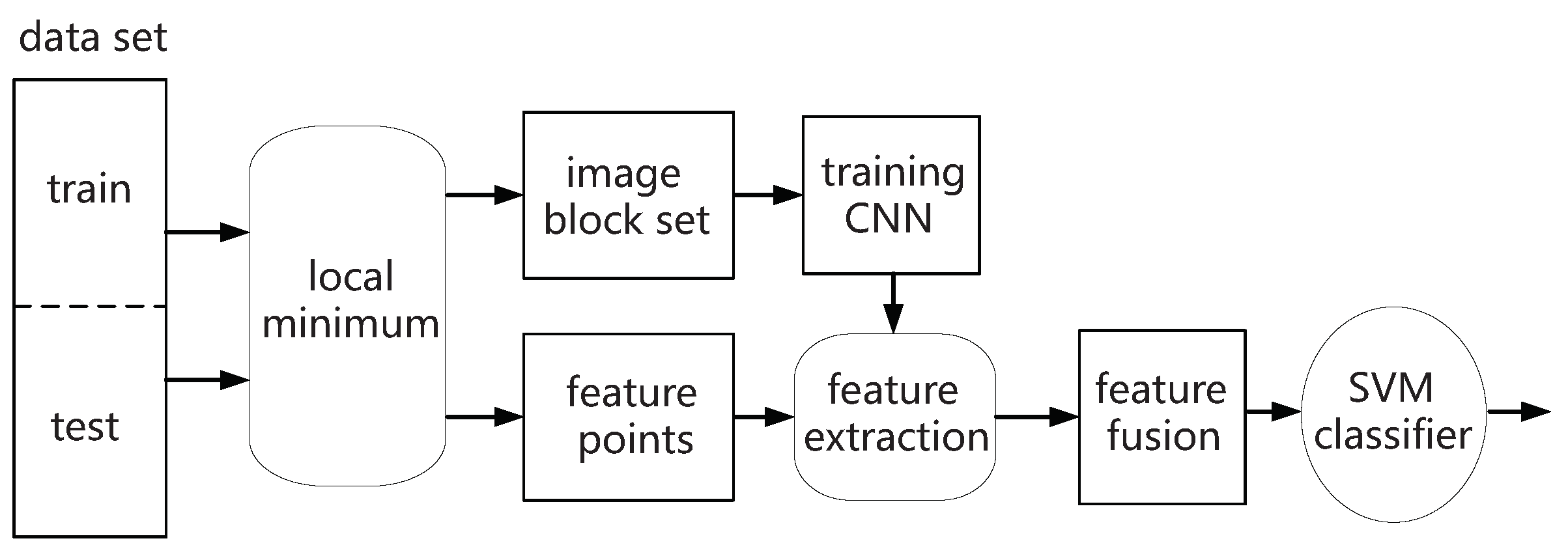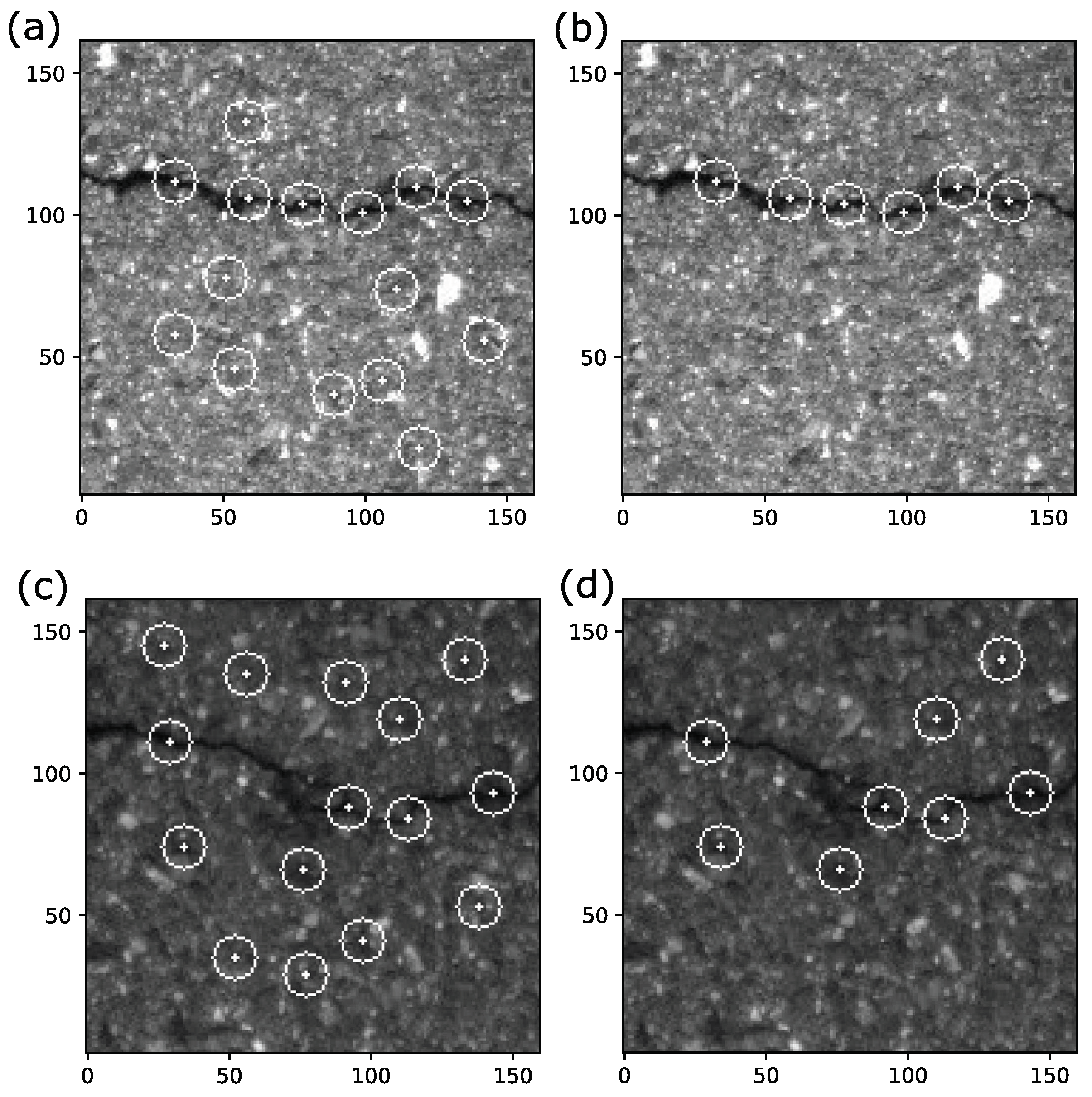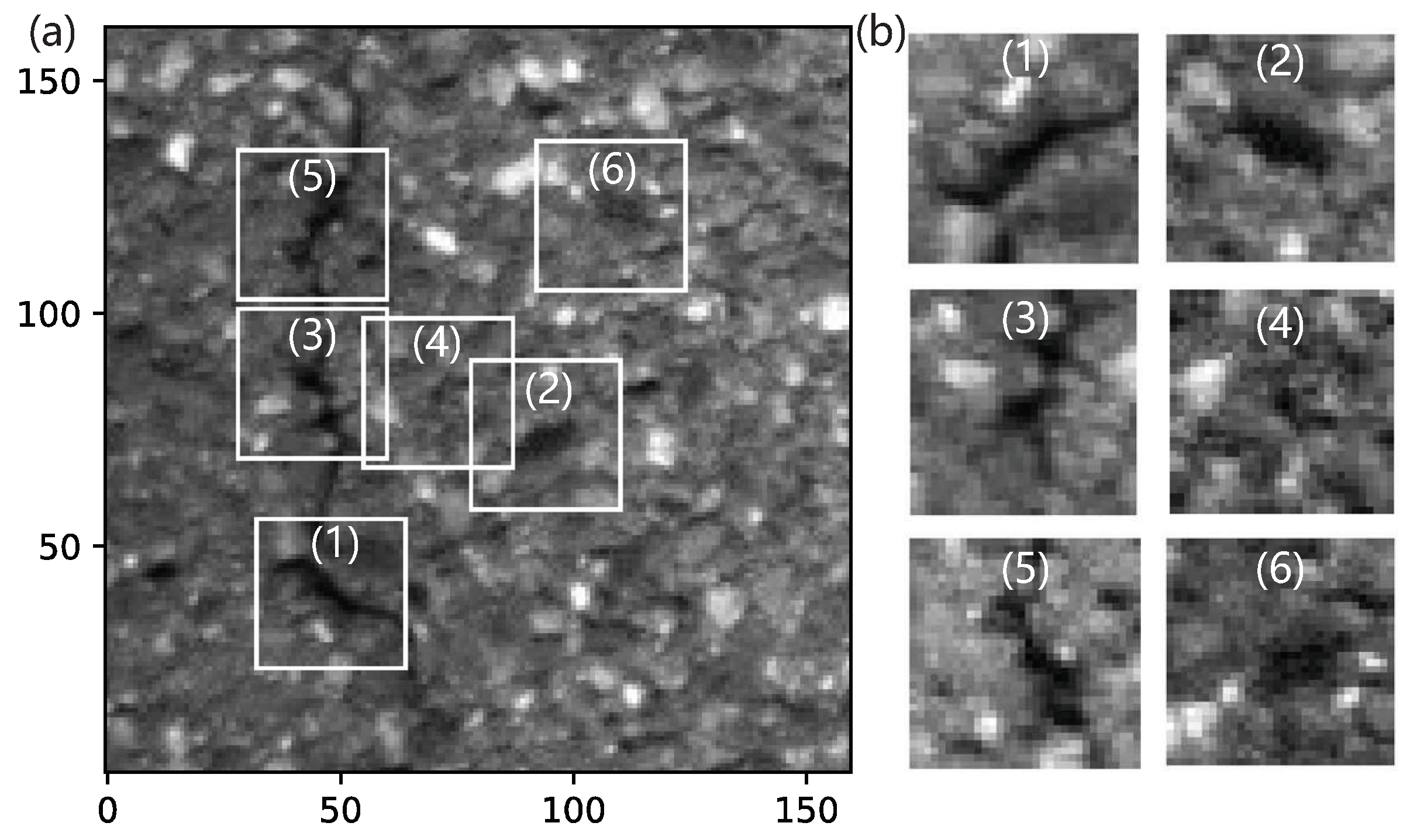Road Pavement Damage Detection Based on Local Minimum of Grayscale and Feature Fusion
Abstract
1. Introduction
2. Methods
2.1. Feature Points Based on Local Minimum of Grayscale
2.2. Extraction of Block Feature by CNN
2.3. SVM Classification
3. Results and Discussion
4. Conclusions
Author Contributions
Funding
Institutional Review Board Statement
Informed Consent Statement
Data Availability Statement
Acknowledgments
Conflicts of Interest
References
- Fang, W.; Zhu, C.; Yu, F.R.; Wang, K.; Zhang, W. Towards Energy-Efficient and Secure Data Transmission in AI-Enabled Software Defined Industrial Networks. IEEE Trans. Ind. Inform. 2022, 18, 4265–4274. [Google Scholar] [CrossRef]
- Fang, W.; Cui, N.; Chen, W.; Zhang, W.; Chen, Y. A Trust-based Security System for Data Collection in Smart City. IEEE Trans. Ind. Inform. 2021, 17, 4131–4140. [Google Scholar] [CrossRef]
- Fang, W.; Zhang, W.; Yang, W.; Li, Z.; Gao, W.; Yang, Y. Trust management-based and energy efficient hierarchical routing protocol in wireless sensor networks. Digit. Commun. Netw. 2021, 7, 470–478. [Google Scholar] [CrossRef]
- Xu, Z.; Che, Y.; Li, J.; Zhao, X.; Pan, Y.; Wang, Z.; Wei, N.; Song, H. Research progress on automatic processing technology for pavement distress. J. Traffic Transp. Eng. 2019, 19, 172–190. [Google Scholar]
- Habib, A.; Kunt, M.M. A framework for pavement crack detection and classification. IOP Conf. Ser. Mater. Sci. Eng. 2020, 800, 012020. [Google Scholar] [CrossRef]
- Chen, H. Deep Learning for Pavement Distress Detection. Ph.D. Thesis, Zhejiang University of Technology, Hangzhou, China, 2020. [Google Scholar]
- Kheradmandi, N.; Mehranfar, V. A critical review and comparative study on image segmentation-based techniques for pavement crack detection. Constr. Build Mater. 2022, 321, 126162. [Google Scholar] [CrossRef]
- Zhang, H.; Wang, Q.; Wei, W. Pavement Distress Detection Based on Artificial Population. J. Nanjing Univ. Sci. Technol. 2005, 29, 4. [Google Scholar]
- Nayyeri, F.; Hou, L.; Zhou, J.; Guan, H. Foreground-background separation technique for crack detection. Comput.-Aided. Civ. Inf. 2019, 34, 457–470. [Google Scholar] [CrossRef]
- Yousaf, M.H.; Azhar, K.; Murtaza, F.; Hussain, F. Visual analysis of asphalt pavement for detection and localization of potholes. Adv. Eng. Inform. 2018, 38, 527–537. [Google Scholar] [CrossRef]
- Jin, H.; Wan, F.; Ye, Z. Pavement crack detection fused HOG and watershed algorithm of range image. J. Cent. China Norm. Univ. 2017, 51, 7415–7722. [Google Scholar]
- Patel, D.R.; Thakker, H.; Kiran, M.B.; Vakharia, V. Surface roughness prediction of machined components using gray level co-occurrence matrix and Bagging Tree. FME Trans. 2020, 48, 468–475. [Google Scholar] [CrossRef]
- Lu, K. Advances in deep learning methods for pavement surface crack detection and identification with visible light visual images. arXiv 2020, arXiv:2012.14704. [Google Scholar]
- Eisenbach, M.; Stricker, R.; Seichter, D.; Amende, K.; Debes, K.; Sesselmann, M.; Ebersbach, D.; Stöckert, U.; Gross, H.-M. How to Get Pavement Distress Detection Ready for Deep Learning? A Systematic Approach. In Proceedings of the 2017 International Joint Conference on Neural Networks, Anchorage, AK, USA, 3 July 2017; pp. 2039–2047. [Google Scholar]
- Simonyan, K.; Zisserman, A. Very deep convolutional networks for large-scale image recognition. arXiv 2014, arXiv:1409.1556. [Google Scholar]
- Hou, Y.; Dong, Y.; Zhang, Y.; Zhou, Z.; Tong, X.; Wu, Q.; Qian, Z.; Li, R. The Application of a Pavement Distress Detection Method Based on FS-Net. Sustainability 2022, 14, 2715. [Google Scholar] [CrossRef]
- Ukhwah, E.N.; Yuniarno, E.M.; Suprapto, Y.K. Asphalt pavement pothole detection using deep learning method based on YOLO neural network. In Proceedings of the 2019 International Seminar on Intelligent Technology and Its Applications, Surabaya, Indonesia, 6 January 2020; pp. 35–40. [Google Scholar]
- Xiang, X.; Zhang, Y.; Saddik, A.E. Pavement Crack Detection Network Based on Pyramid Structure and Attention Mechanism. IET Image Process. 2020, 14, 1580–1586. [Google Scholar] [CrossRef]
- Chen, G.-H.; Ni, J.; Chen, Z.; Huang, H.; Sun, Y.-L.; Ip, W.H.; Yung, K.L. Detection of Highway Pavement Damage Based on a CNN Using Grayscale and HOG Features. Sensors 2022, 22, 2455. [Google Scholar] [CrossRef]
- Salama, M.; Kader, H.A.; Abdelwahab, A. An analytic framework for enhancing the performance of big heterogeneous data analysis. Int. J. Eng. Bus. Manag. 2021, 13, 1847979021990523. [Google Scholar] [CrossRef]
- Ibragimov, E.; Lee, H.J.; Lee, J.J.; Kim, N. Automated pavement distress detection using region based convolutional neural networks. Int. J. Pavement Eng. 2022, 23, 1981–1992. [Google Scholar] [CrossRef]
- Li, Z.; Xu, G.; Cheng, Y.; Wang, Z.; Wu, Q. Pavement Crack Detection Using Progressive Curvilinear Structure Anisotropy Filtering and Adaptive Graph-Cuts. IEEE Access 2020, 8, 65020–65034. [Google Scholar] [CrossRef]
- Laganiére, R. OpenCV2 Computer Vision Application Programming Cookbook, 2nd ed.; Packt Publishing Ltd.: Birmingham, UK, 2014; pp. 167–188. [Google Scholar]
- Chong, Y.; Ai, W.; Xu, G. Image Enhancement of Empirical Mode Decomposition Based on Local Gradient Extreme Point. Ordnance Ind. Autom. 2020, 39, 28–31. [Google Scholar]
- Vincent, L. Morphological Grayscale Reconstruction: Definition, Efficient Algorithm and Applications in Image Analysis. In Proceedings of the 1992 IEEE Computer Society Conference on Computer Vision and Pattern Recognition, Champaign, IL, USA, 6 August 2002; pp. 633–635. [Google Scholar]
- Yang, X.; Li, H.; Yu, Y.; Luo, X.; Huang, T.; Yang, X. Automatic Pixel-Level crack detection and measurement using fully convolutional network. Comput.-Aided. Civ. Inf. 2018, 33, 1090–1109. [Google Scholar] [CrossRef]
- Yang, F.; Zhang, L.; Yu, S.; Prokhorov, D.; Mei, X.; Ling, H. Feature pyramid and hierarchical boosting network for pavement crack detection. IEEE Trans. Intell. Transp. Syst. 2020, 21, 1525–1535. [Google Scholar] [CrossRef]
- Ding, M.; Li, L. CNN and HOG Dual-Path Feature Fusion for Face Expression Recognition. Inf. Control 2020, 49, 47–54. [Google Scholar]
- Qu, Z.; Cao, C.; Liu, L.; Zhou, D. A Deeply Supervised Convolutional Neural Network for Pavement Crack Detection With Multiscale Feature Fusion. IEEE Trans. Neural Netw. Learn. Syst. 2022, 33, 4890–4899. [Google Scholar] [CrossRef] [PubMed]
- Stricker, R.; Eisenbach, M.; Sesselmann, M.; Debes, K.; Gross, H.-M. Improving Visual Road Condition Assessment by Extensive Experiments on the Extended GAPs Dataset. In Proceedings of the 2019 International Joint Conference on Neural Networks, Budapest, Hungary, 30 September 2019; pp. 1–8. [Google Scholar]
- Wang, J.J.; Wang, Y.K.; Zhang, F.; Zhang, S.W.; Dai, Y.; Yu, X.D. Real-Time Detection for Eye Closure Feature of Fatigue Driving Based on CNN and SVM. Comput. Syst. Appl. 2021, 30, 118S–126S. [Google Scholar]





| Type | Filter Size | Stride | Output Shape | Parameters |
|---|---|---|---|---|
| in | N/A | N/A | (32,32,1) | N/A |
| conv | 3 × 3(64) | (1,1) | (30,30,64) | 640 |
| conv | 3 × 3(64) | (1,1) | (28,28,64) | 36,928 |
| pool | 2 × 2 | (2,2) | (14,14,64) | |
| conv | 3 × 3(128) | (1,1) | (12,12,128) | 73,856 |
| pool | 2 × 2 | (2,2) | (6,6,128) | |
| conv | 3 × 3(128) | (1,1) | (4,4,128) | 147,584 |
| flat | N/A | N/A | 2048 | N/A |
| fc | (128) | N/A | 128 | 262,272 |
| fc | (64) | N/A | 64 | 8256 |
| out | (2) | N/A | 2 | 130 |
| Total parameters: 529,666. |
Publisher’s Note: MDPI stays neutral with regard to jurisdictional claims in published maps and institutional affiliations. |
© 2022 by the authors. Licensee MDPI, Basel, Switzerland. This article is an open access article distributed under the terms and conditions of the Creative Commons Attribution (CC BY) license (https://creativecommons.org/licenses/by/4.0/).
Share and Cite
Jin, W.-W.; Chen, G.-H.; Chen, Z.; Sun, Y.-L.; Ni, J.; Huang, H.; Ip, W.-H.; Yung, K.-L. Road Pavement Damage Detection Based on Local Minimum of Grayscale and Feature Fusion. Appl. Sci. 2022, 12, 13006. https://doi.org/10.3390/app122413006
Jin W-W, Chen G-H, Chen Z, Sun Y-L, Ni J, Huang H, Ip W-H, Yung K-L. Road Pavement Damage Detection Based on Local Minimum of Grayscale and Feature Fusion. Applied Sciences. 2022; 12(24):13006. https://doi.org/10.3390/app122413006
Chicago/Turabian StyleJin, Wei-Wei, Guo-Hong Chen, Zhuo Chen, Yun-Lei Sun, Jie Ni, Hao Huang, Wai-Hung Ip, and Kai-Leung Yung. 2022. "Road Pavement Damage Detection Based on Local Minimum of Grayscale and Feature Fusion" Applied Sciences 12, no. 24: 13006. https://doi.org/10.3390/app122413006
APA StyleJin, W.-W., Chen, G.-H., Chen, Z., Sun, Y.-L., Ni, J., Huang, H., Ip, W.-H., & Yung, K.-L. (2022). Road Pavement Damage Detection Based on Local Minimum of Grayscale and Feature Fusion. Applied Sciences, 12(24), 13006. https://doi.org/10.3390/app122413006









